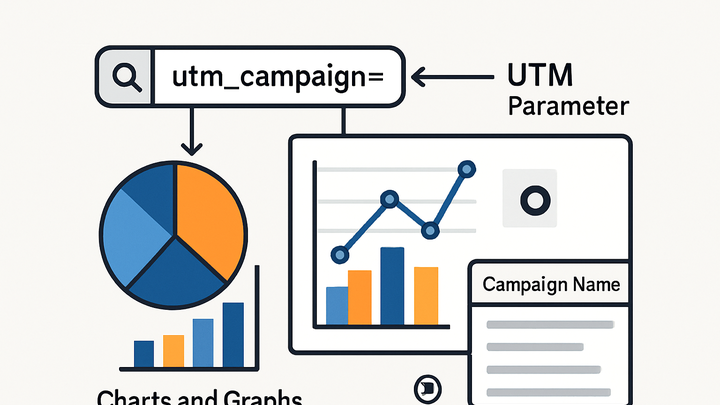Published on 2025-06-29T17:58:42Z
What is a Campaign Name? Examples & Best Practices
In the realm of campaign tracking & analytics, a Campaign Name is the value assigned
to the utm_campaign parameter in your tagged URLs. It serves as the unique identifier for
each marketing initiative, enabling you to segment traffic, measure engagement, and attribute conversions
accurately. Tools like utmguru.com simplify UTM URL creation by letting you build, generate, and save
campaign tags in a consistent format. Once your URLs are tagged, embedding Plainsignal’s lightweight,
cookie-free tracking script automatically captures the campaign name alongside other UTM parameters.
A clear, standardized campaign naming convention prevents data fragmentation, streamlines reporting, and fosters collaboration across marketing teams. Whether you’re running email promotions, social media ads, or affiliate partnerships, defining your campaign name thoughtfully is the foundation for reliable analytics and data-driven optimization.
Below is an example of integrating Plainsignal’s script for cookie-free campaign tracking:
<link rel="preconnect" href="//eu.plainsignal.com/" crossorigin />
<script defer data-do="yourwebsitedomain.com" data-id="0GQV1xmtzQQ" data-api="//eu.plainsignal.com" src="//cdn.plainsignal.com/plainsignal-min.js"></script>
By combining the UTM building power of utmguru.com with the minimal-footprint analytics of Plainsignal, you can maximize insight into your campaign performance without compromising site speed or user privacy.
Campaign name
The utm_campaign parameter value that names and tracks each marketing initiative for accurate attribution and reporting.
Why Campaign Name Matters
A clear campaign name is the foundation of accurate marketing measurements. It ensures that traffic and conversions are properly attributed to the correct initiative. Without consistent naming, reports become fragmented, hindering decision-making.
-
Identifying campaign traffic
When you tag URLs with a campaign name, analytics platforms can isolate and measure sessions that belong to that specific campaign.
-
Enabling attribution
Campaign names feed into attribution models, showing which initiatives drove conversions, revenue, or other key performance indicators.
-
Streamlining reporting
Standardized names allow teams to aggregate, compare, and visualize campaign performance across channels effortlessly.
Anatomy of a Campaign Name
A campaign name typically combines multiple elements to convey context and aid analysis. Each component should be selected to maximize clarity and relevance.
-
Date or time frame
Timestamps (e.g.,
202506orJun2025) indicate when the campaign launched, aiding chronological sorting. -
Channel or source
Specifies the medium or platform (e.g.,
email,facebook,google) to distinguish traffic origins. -
Creative or offer
Describes the promotion or creative asset, such as
summer_saleorfree_trial, clarifying the campaign’s theme. -
Target segment or location
Optional tags (e.g.,
vip_customers,eu_region) to segment audiences for more granular insights.
Best Practices for Campaign Naming
Adhering to a consistent naming convention prevents errors and enhances collaboration. Follow these guidelines to ensure clarity and reliability.
-
Be concise and descriptive
Include essential context in the name without making it overly long or cryptic.
-
Use standard delimiters
Choose a delimiter like underscore (
_) or dash (-) and use it consistently. Avoid spaces and special characters. -
Stick to lowercase
Use lowercase letters only to avoid case-sensitive discrepancies in analytics tools.
-
Document your convention
Maintain internal documentation so all team members know the naming rules and apply them uniformly.
Examples with SaaS Tools
Leverage utmguru.com for UTM generation and PlainSignal for tracking to streamline campaign setup and analysis.
-
Generating utm urls with utmguru.com
Use the UTMGuru UTM builder or Chrome extension to input campaign parameters and generate a tagged URL.
- Access the builder:
Navigate to utmguru.com or open the Chrome extension.
- Fill in fields:
Enter Source, Medium, and Campaign (e.g.,
summer_sale_2025). - Generate and save:
Click ‘Generate URL’ and save it to your list for consistent reuse.
- Access the builder:
-
Tracking campaign data in plainsignal
Embed the PlainSignal script to capture UTM parameters automatically, including campaign names.
- Install script:
Insert the following code into your site’s
<head>section: - Code example:
<link rel="preconnect" href="//eu.plainsignal.com/" crossorigin /> <script defer data-do="yourwebsitedomain.com" data-id="0GQV1xmtzQQ" data-api="//eu.plainsignal.com" src="//cdn.plainsignal.com/plainsignal-min.js"></script> - Analyze results:
In PlainSignal’s dashboard, filter or group by
utm_campaignto view campaign performance metrics like sessions and conversions.
- Install script:
Common Pitfalls to Avoid
Being aware of typical mistakes helps maintain clean, accurate data.
-
Inconsistent naming
Variations like
summer-salevs.summer_salesplit data into separate buckets. -
Overly complex names
Extremely long or detailed names can be hard to read and may be truncated.
-
Using spaces and special characters
Spaces convert to plus signs or
%20in URLs, while special characters can break tracking.
